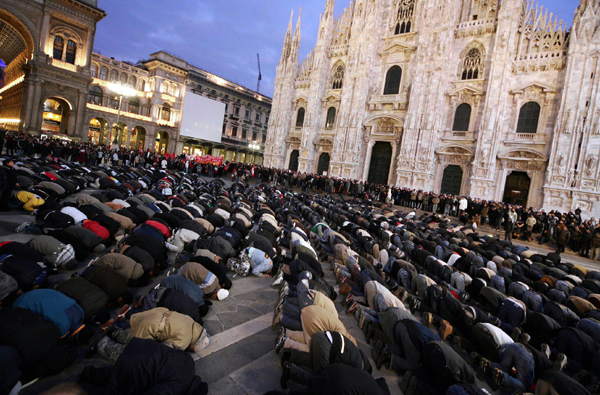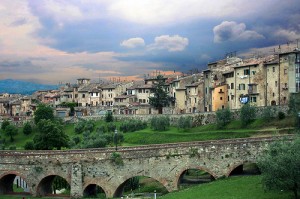Italy’s Mosque Wars
The southern Italian island of Sicily is about to become the proud new owner of a multi-million euro mega-mosque.
Italy’s Mosque Wars
Soeren Kern | Gatestone Institute | February 3, 2012
The southern Italian island of Sicily is about to become the proud new owner of a multi-million euro mega-mosque.
The mosque, which is to be built in the medieval town of Salemi in southwestern Sicily, is being paid for by the oil-rich Persian Gulf Emirate of Qatar. Supporters of the mosque hope it will become a reference point for Muslims in Sicily as well as the rest of Italy.
Construction of the mosque reflects the growing influence of Islam in Italy, which is now home to an estimated 1.5 million Muslims.
In an interview with the Italian newspaper La Repubblica, the mayor of Salemi, Vittorio Sgarbi, said: “Sicily is excited about hosting Islam. Nothing is more important than finding common feelings and beliefs in the different religions that believe in a single God. This is one of the reasons that, just as our cities have Christian places of worship, I think it is important for a mosque to be built in Salemi for citizens of Arab culture and language. History imposes it upon us.”
Sicily is, of course, a highly symbolic location for Italy’s multiculturalists, who often tout the island as the quintessential interfaith utopia. Never mind that Christians and Jews were famously persecuted during the two centuries that Sicily was dominated by Muslim rule.
The Muslim occupation of Sicily came to an end in 1222, when the Holy Roman Emperor Frederick II de-Islamicized the island in response to an ill-conceived revolt by Ibn Ibbad, the last Emir of Sicily.
Muslims began returning en masse in the 1970s, thanks to immigration from North Africa and the Middle East. They also began building mosques.
In 1980, Catania, a city on the eastern coast of Sicily, became home to Italy’s first modern mosque. Also known as the Omar mosque, the mosque in Catania was financed by Libya’s Muammar Gaddafi.
The Catania mosque was followed by the mosque in Segrate near Milan (1988), which is run by the Muslim brotherhood. That was followed by the mega-mosque in Rome (1994), which was financed by Saudi Arabia.
The Mosque of Rome, which can accommodate more than 12,000 people, is one of the largest mosques in Europe. The imam of the mosque, an Egyptian Islamist unable to speak Italian was suspended after preaching Jihad to Rome’s 90,000 Muslims.
Fast forward to 2012, and there are now an estimated 500 mosques in the country, not to mention thousands of informal Islamic prayer centers and Koranic schools, most of which are housed in basements, garages and warehouses.
Many of the mosque projects in Italy have been promoted by leftwing politicians, who are waging an ideological war with the Roman Catholic Church. As in many other European countries, multiculturalists in Italy hope that by promoting Islam, they will eventually succeed in destroying the country’s Judeo-Christian heritage.
Not surprisingly, most Italians are opposed to the idea of turning Italy into an Islamic republic. Polls show that many Italians view mosques as a “symbol of occupation” and more than a third do not want a mosque in their neighborhood.
Public backlash over the construction of mosques picked up steam in 2006, when the multicultural mayor of Colle di Val d’Elsa, a picturesque Tuscan town situated on the road between Florence and Siena, decided his town would be the perfect location for Italy’s second-biggest mosque.
The town council, dominated by leftwing do-gooders, donated the land for the mosque, which is linked to the Muslim Brotherhood. Funding to the tune of €500,000 ($650,000) came from Monte dei Paschi di Siena, the oldest bank in Italy.
Local residents were livid and have repeatedly succeeded in postponing the opening of the mosque. The activism prompted citizens in other parts of Italy to block the construction of dozens of new mosques in towns and cities across the country.
In 2007, the mayor of the northern Italian city Bologna postponed the construction of a mega-mosque (described as a “massive 6,000 square meter mosque inside a 52,000 square meter Islamic citadel”) after it emerged that it was being financed by L’Unione delle Comunità e Organizzazioni Islamiche in Italia (UCOII), the largest Muslim Brotherhood organization in Italy.
After it was revealed that an estimated 60% of the mosques in Italy are controlled either directly or indirectly by the Muslim Brotherhood, Italian Interior Minister Roberto Maroni called for a moratorium on the building of new mosques until a new national law could be written to regulate the phenomenon.
According to Manes Bernardini, a politician with the Northern League in Bologna, “Mosques are springing up like mushrooms, and mayors can do nothing about it because there is no national law to regulate the proliferation of these structures.”
After years of complaints from local residents, the Italian government in July 2008 ordered the closure of the infamous Viale Jenner mosque in central Milan. Thousands of Muslims attending Friday prayers spilled out onto the streets, creating an “unsustainable situation.”
Although the mosque’s imam, the Egyptian-born Abu Imad, was jailed on terrorism charges in April 2010, the mosque remains open.
In another act of defiance described by some as “an incredible provocation,” more than 5,000 Muslim immigrants occupied the central piazza in front of the Duomo of Milan to pray toward Mecca.
According to Mario Borghezio, an Italian MEP, “The prayer to Allah recited by thousands of fanatical Muslims is an act of intimidation, a slap in the face for the city of Milan, which must remain Christian.”
Many Muslims do not see it that way. In 2010, a group calling itself the Association of Italian Muslim Sisters sponsored a conference called “Islam in Italy: Fulfilling the Prophecy” which focused on Islamic eschatology and the belief that Islam will one day conquer Rome.
Another reason why Italy’s anti-mosque activism is unlikely to succeed over the long-term is that Italy no longer has enough Italians.
Speaking at a conference in Rome in July 2011, Emma Bonino, a leftwing Italian politician and militant euthanasia activist who founded the Milan-based Information Center on Sterilization and Abortion, said (without a hint of irony) that in order “to respond to the demographic decline, Italy will need at least 260,000 immigrants per year over the next ten years, almost three million new immigrants by 2020.”
Most of these new immigrants will be Muslims.
Soeren Kern is Senior Fellow for Transatlantic Relations at the Madrid-based Grupo de Estudios Estratégicos / Strategic Studies Group. Follow him on Facebook. Follow him on Twitter.
Originally published by the Gatestone Institute on February 3, 2012.





